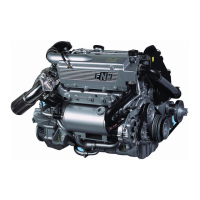12 – FNM® Series HPE – Installation Manual
3.4 Principles of preparation of the engine
compartment
The engine compartment houses the propulsive units and has
several functions: it allows to keep the engine cool and dry,
still on the longitudinal members, ensuring ventilation and the
air flow required for its operation. Finally it contains all the
accessories and auxiliary parts necessary for the operation of
the entire propulsion system.
It is necessary to pay attention to the design and construction
of the engine compartment. The walls must be built so that
rainwater and splashes of sea water do not go directly against
the engine or suction devices.
3.4.1 Longitudinal members
The longitudinal members must be straight and oriented in the
direction of the hull length. They must be quite stiff and firm to
hold the engine and keep its alignment over time.
The distance provided for each engine (indicated by the letter
d in the image of Figure 8) between the centre of the right
longitudinal member and of the left longitudinal member is
shown in the following table:
Distance d between the longitudinal members centres
[mm]
Figure 8 – Longitudinal members
The side members must completely contain the basis of the
anti-vibration mountings and have margin to be able to move
in the future, in case it is necessary to realign the engine.
Use screws of adequate size to secure the engine to the
supports. All the forces exerted by water on the hull of the boat
are transmitted to the engine through the side members, and
therefore to the fixing screws. Also make sure there is enough
space on the bottom of the boat between the engine and the
hull.
3.5 Ventilation
The requirements for engine ventilation vary considerably
among the different ship designs. The manufacturer of the
boat is responsible for their construction and the correct
application of the principles of ventilation, in accordance with
regulations.
The ventilation of the engine compartment has multiple
functions. It must supply the engine with air for combustion
and maintain the temperature inside low. The purpose is to
ensure a correct air flow rate necessary for the proper
operation of the engine and to reduce the risk of moisture and
condensation.
3.5.1 Reduction of condensation
Figure 9 - Engine compartment ventilation diagrams
In the image of Figure 9, the fan represented is appropriate for
adequate ventilation of the compartment in order to reduce the
presence of moisture and condensation. It should be applied
also in cases where the shape of the engine compartment
does not favour a correct air passage around the entire
engine.
3.5.2 Ventilation openings
In the engine compartment must always enter air at the lowest
temperature possible; warm air must be discharged upwards.
The vents must not allow access to rain water or to splashes
of seawater during navigation.

